Virginia Rail
A Note About Late Summer Wetlands in Central Ohio
As I write this, the Honda Wetlands, my favorite marshy area, has been drying up. August has seen a steady decline in the amount of free water standing among the cat-tails there.
I took most of the pictures in this post a couple of weeks ago, when the water level was higher, at the time of my last marsh bird post. Don’t rush right out and try to see these birds now- they could very well be elsewhere.
And now, on to our featured bird!
Virginia Rail
Rails, like other marsh birds, can be elusive. Not a few birders come to the Honda Wetlands specifically to see one of these birds.
Earlier this month, I was quite lucky and saw a number of marsh birds that I thought would be harder to see. I’m guessing that a shrinking amount of open water had something to do with this. And perhaps younger birds behave differently than adults- in this case, juveniles were easier to spot than their parents.
It’s not particularly wise to generalize across a whole family of birds, but Rails often live in dense vegetation near water, have an omnivorous diet, and are quite shy. Unless you frequent marshy areas, chances are you haven’t seen many of them. I hadn’t, until this year.
Virginia Rails are very well-adapted to their environment. They have large feet and long toes for walking on marshy ground and aquatic vegetation. They are narrow when viewed head-on, which facilitates moving through dense foliage. Their forehead feathers are robust, allowing them to push their heads through such plants as reeds and cat-tails. Their bill is fairly long for finding food in mud or water. Give a chicken a long bill and they might resemble this bird.
There were a couple of adult Virginia Rails in the Honda Wetlands this July, but, true to form, they weren’t easy to get a good look at. This picture is rather typical of the murky views I’d glimpse:
These birds felt like staying in the cat-tails much of the time. It turns out that they were raising a family there, and even then, they were quite secretive. They built multiple nests, only one of which actually contained eggs.
In August, the water level receded, meaning there were less places to hide in the marsh while feeding. Also, a few young Virginia Rails suddenly appeared. These juveniles were less shy than their parents, which made photography much less frustrating. Here are 3 in the same picture.
These birds are rather precocial. This means that, unlike Robins for instance, they leave the nest quickly and fend for themselves. The day after they were hatched, they were out among the cat-tails and searching for food on their own. How’s that for an abbreviated childhood?
Notice how big the feet are on these birds. I’m sure it makes walking around in the muck a lot easier. If their feet remind you of Coot feet, that makes sense- Coot are a member of the Rail family.
When the light was right, you could see their eye clearly- a blue or gray iris.
One of these juveniles in particular was quite calm about being near the boardwalk where we birders stood, cameras clicking. It would forage so close that I’d have to reduce the magnification of my lens at times. This particular bird seemed to limp slightly, but this didn’t interfere with it finding food.
This bird looked quite handsome with the various patterns its feathers sported.
It would often probe around the base of cat-tails for food.
Further out in the marsh, one of the adults showed itself- perhaps seeing the kids doing alright out in the open relaxed this one somewhat. Notice the rich auburn plumage and bright orange bill.
Stretching- I bet that feels good!
Here’s one starting to take off back into the cat-tails.
These are fascinating birds to watch. I’m glad they decided to come out for a stroll!


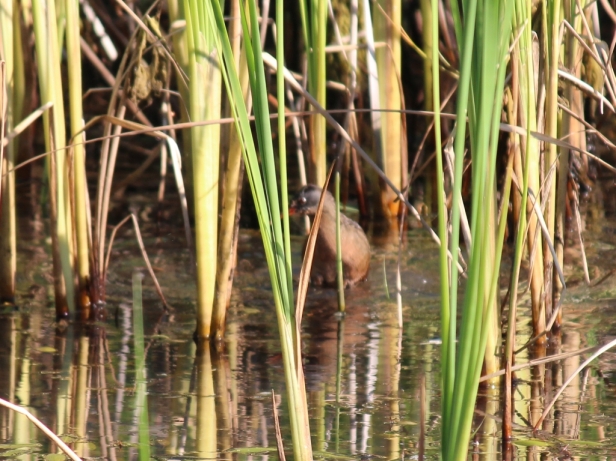

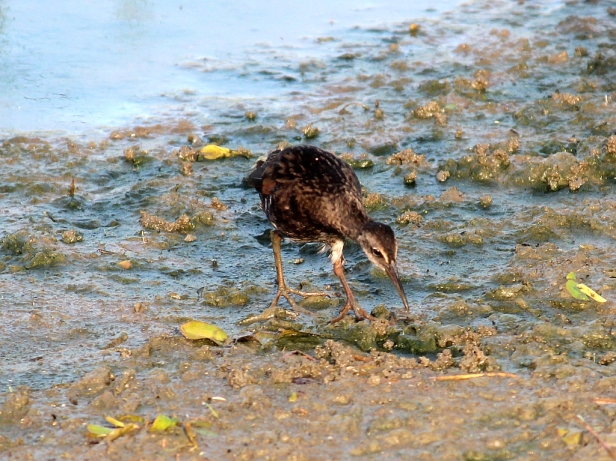

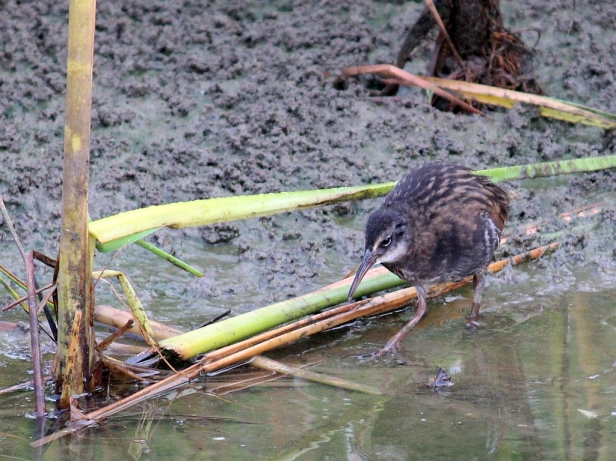
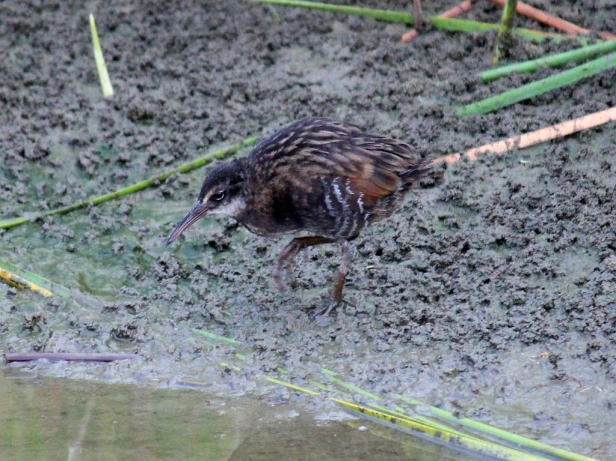

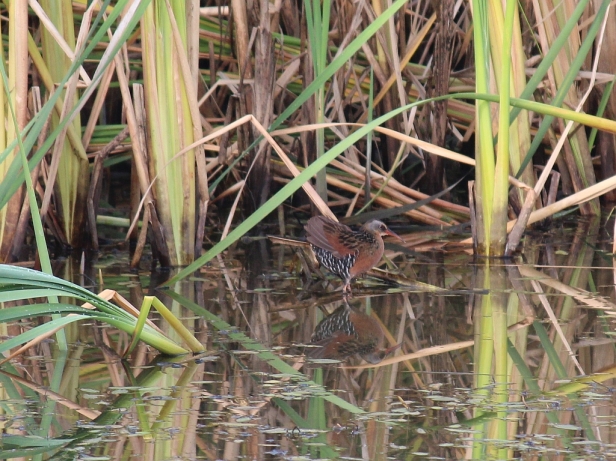
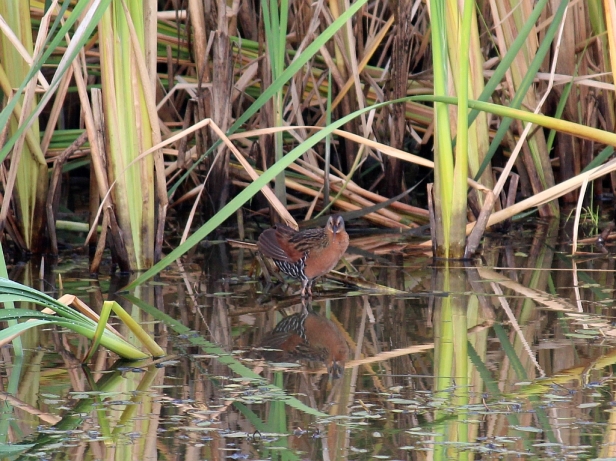


I’ve never seen one or any bird that looks like it. They are quite interesting.
I felt the same way when I saw them- the funny part is, seeing other species of rails, herons, bitterns there…they started looking somewhat alike. Interesting mechanisms at work here in terms of appearance, camouflage, and so on.
Love the colors of the adult, they are an interesting looking bird. Your pictures were incredible, as always. 🙂
The adult’s auburn color was very rich and attractive! The little ones were really fun to watch too 🙂
For me, Honda Wetlands was someplace I just had to visit. With all the Rail activity, especially the King rail, I had to see for myself. Enjoyed your article and pictures.
Thanks, Les! I’ll be posting about that bird you mentioned one of these days 😉
Terrific series of photos! Those are very interesting birds and a species that I’ve never seen. I appreciate getting to see them!
Thanks Montucky! I was very interested in them as well as I’d never seen the like before either.
Brilliant…this also reminds me of a wetland park visited awhile ago. Keep up the good work:)
Many thanks, sugali! Wetlands are interesting to me because they’re so different an experience.
Interesting birds – I’ve never seen or heard of them before. Love the auburn coloring… I was going to ask you if you wore wader boots to get these pictures until you mentioned the boardwalk! Thanks for sharing these lovely photos.
Oh that boardwalk is a life-saver, Barbara! I’ve seen deer and rabbits in the wetlands, but unless the ground dries out, I’m afraid I’d be stuck for sure! 🙂
gorgeous pictures! You just liked my bluebird painting on Words And Peace (Wordless Wednesday post), so I came to visit you. Did you look at my other bird paintings? all on rocks: http://www.rocksbyemmanuelle.com/birds
I just finished another American goldfinch and an indigo bunting, will post them soon.
Thanks for visiting my blog. Emma
Thanks for visiting, Emma! I like your work!
Cool birds and great photos of them!
Thanks quietsolopursuits! I’ve enjoyed your recent posts by the way!
Every moment captured beautifully.
Island Traveler, thank you.
If you haven’t visited his site, it’s well worth it! http://consumerjournaldotnet.wordpress.com/
Amazing pictures. If the name of that bird is the Virginia Rail, might I expect to see one here in Virginia? By the way, I invited you to take the Seven Links Challenge. Stop by my blog and read about it. Remember, it’s an invitation. You don’t have to accept.
Thanks, Susan! Virginia Rails live year-round along the Virginia seashore, according to my Sibley Field Guide to Birds. They migrate over the rest of the state in the spring and the autumn. I was really surprised to see them, since they were quite shy on my earlier visits. I’m guessing that they can be seen easiest under certain conditions, such as migration or when wetlands are seasonally shrinking.